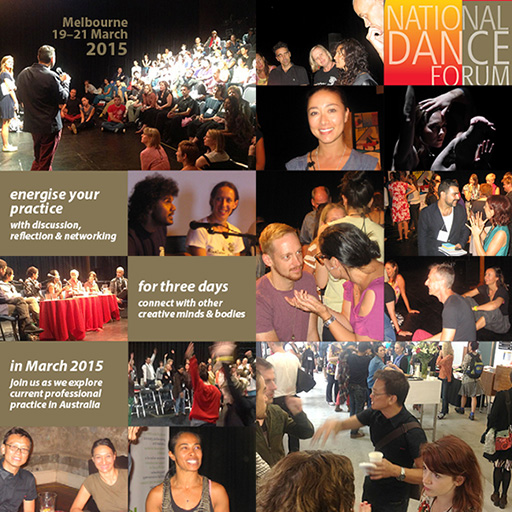Andrew Morrish, in his opening provocation for this year’s National Dance Forum, has asked us to consider our existence as a dance community.
Andrew writes:
I primarily want us to have an experience of our community, its layers and textures, its colours and its voices… I believe that a feeling of being part of the community of dance is an under-utilised resource for surviving as a dance artist.
He goes on to describe a diversity in aesthetics and ambitions as being key to community health. I agree.
As a colleague of mine once described, community is like compost, you need layers of soft material, hard material and, well, manure to make it a thriving microcosm of productive activity. He suggested that all elements are essential if we are to avoid a stinking, rotting mass that does nothing but emit greenhouse gases.
How do we continue to refresh our community’s supply of diverse ingredients?
How do we set aside the competitive impulse that is fostered by funding rounds and curated programs to find a sense of community?
Is ‘community’ a nicety of the established and the regularly financed while the rest of us are just scrabbling to find the next job?
If we reflect for a moment, we might be able to see that a healthy community can generate a social, creative and dare I say, economic vitality that indeed will take us to the next job.
In 2007 I heard the organisational psychologist Ian Plowman speak about his research commissioned by the Department of Primary Industries. The research examined why some rural towns thrived while others died. The result of this research became a powerful advocating foundation for those of us that work in regional communities. Plowman’s suggestions can help us understand the activity that could sustain a thriving dance (or any other) community.
Like all good stories, Plowman starts with a warning. Leadership, he says, is a two-edged sword. It can be an act of responsibility, it can also be the act of denying someone access to experience or community. He found that the more leadership responsibility was shared, the more innovation occurred.
He offers a range of useful, practical strategies that can help our dance community to thrive. Firstly, he says we need to support mobility. That a community needs to be 'receptive to the inflow of talent' by opening up ideas of ‘who’s allowed in’, so we can receive new skills, ideas and experience that increase vitality. Mobility is also about the flow outward, the freedom to leave and come back. Does holding artists under the banners of ‘regional’, ‘interdisciplinary, ‘from Melbourne’ help or impede this flow?
One way to encourage mobility is to welcome newcomers in an active way, not just leaving them to prove themselves or perish. Welcoming newcomers is good for all of us; it means the newcomers are more likely to invest themselves and their resources into the life of our dance community. One way to be welcoming is to watch our mouths, to have a gentle control over the convoluted language we’ve created and moderate its alienating effect. It’s a pleasure to speak in our special language, but we must acknowledge it's an exclusive language and keep ourselves in check with the newbies.
Speaking of newbies, Plowman suggests we actively support young people in a way that meets their needs and ambitions, that reveals pathways throughout a career and keeps the boundaries with the rest of the world easily open.
Plowman becomes quite dramatic when speaking about his next recommendation to invest in diversity. He writes, 'communities intolerant of diversity are destined to DIE'. Innovation and creativity come from a blending (dare I say composting) of diverse ideas and experience.
Plowman notes that communities that are dying have incumbent leaders and passive supporters. Communities that are thriving have 'a constantly evolving dynamic of creative coalitions made of people who roll their sleeves up without being asked and who seek no credit for doing so'. Who’s game for that!
Finally, he champions celebration. Communities that celebrate have unity and identity.
If we follow this thinking, a vibrant dance community is one that shares responsibility and leadership, is fluid about its membership, welcomes newcomers and supports young people. It is diverse and invests in building the capacity of its members and makes time to celebrate.
In 2015, will we share in the responsibility of making the National Dance Forum a celebration of community? Let’s make us some good compost!
You can find more information about Ian Plowman in his paper Innovation in rural Queensland: Why some towns thrive while others languish.


